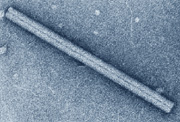
In 1898, Martinus W. Beijerinck, a Professor of Microbiology at the Technical University at Delft, the Netherlands, put forth his concepts that viruses were small and infectious. He defined the infectious agent as a "contagium vivum fluidum", after he discovered that the virus readily passed through a porcelain filter, suggesting that it was smaller than bacteria. He also observed that the 'agent' could diffuse through agar that retained bacteria, and furthermore, that the virus could not be cultured except in living, growing plants. The virus was
Tobacco mosaic virus (TMV). This report, suggesting that 'microbes' need not be cellular, was to forever change the definition of pathogens. In 1898, two Germans, Loeffler and Frosch, former students of Koch, also used a porcelain filter for the isolation of the causal agent of foot and mouth disease of cattle, but they suggested that it was a very small microbe. Beijerinck was almost alone in his forward thinking conclusions that he had a filterable, invisible infectious agent that differed from small microbes. In fact, it took 50 years to prove that TMV was an infectious nucleoprotein.

In that time, TMV was the first virus to be purified in pure crystal form, the first pathogen to be passed through filter candles, and the first virus to be identified as composed of an infectious nucleic acid. Since then many viruses have been discovered in plants, animal, fungi, and bacteria. TMV would continue to play a leading role in the development of fundamental concepts in virology. In the 1960s and 1970s, TMV was a key component in the shift to molecular work in viruses, particularly with regard to the understanding of genetic information and the biological role of virus encoded proteins.
The history of TMV roughly parallels the early history of the American Phytopathological Society (APS) that was founded in 1908 and celebrates its 90th anniversary this year. At the 50th anniversary meeting of APS, W. M. Stanley (APS member, Nobel prize 1946 for crystallization of TMV) commented that the papers on TMV "demonstrate in no uncertain terms the great debt that the field of general virology owes to plant virus research". At this same meeting, J. G. Horsfall stated: "The tobacco mosaic virus is leading us and will surely lead us further into a knowledge of what life itself really is."
As part of the celebration of a century of virology, a TMV symposium was held at the Royal Society of Edinburgh in August 1998. Links to some of the original research on TMV, discussion regarding its significance to virology, and the significance of TMV as a plant pathogen are provided below.
Selected References
Beijerinck, M.W. 1898. Concerning a contagium vivum fluidium as a cause of the spot-disease of tobacco leaves. Reprint from: Phytopathology Classics, Number 7. 1942. James Johnson, translator, APS Press. CLICK HERE TO DOWNLOAD THE FULL TEXT OF THIS WORK.
Creager, A.N., K.-B.G. Scholthof, V. Citovsky, H.B. Scholthof. 1999. Tobacco mosaic virus: Pioneering research for a century. Plant Cell. 11:301-308. CLICK HERE TO GO TO THE FULL TEXT OF THIS ARTICLE.
Holton, C.S., G. W. Fischer, R. W. Fulton, H. Hart, and S. E. A. McCallan (eds.). 1959. Plant Pathology: Problems and Progress, 1908-1958. University of Wisconsin Press.
Scholthof, K.-B.G. 2000. Tobacco mosaic. The Plant Health Instructor. DOI: 10.1094/PHI-I-2000-1010-01.
Scholthof, K.-B.G., J.G. Shaw, M. Zaitlan (eds.). 1999. Tobacco mosaic virus: One hundred years of contributions to virology. APS Press. CLICK HERE FOR MORE INFORMATION.
Zaitlin, M. 1998. The discovery of the causal agent of the tobacco mosaic virus disease. In: "Discoveries in Plant Pathology," S.D. Kung and S.F. Yang (eds.). World Publishing Co., Ltd. Hong Kong. Pp. 105-110. CLICK HERE FOR THE FULL TEXT OF THIS WORK.
